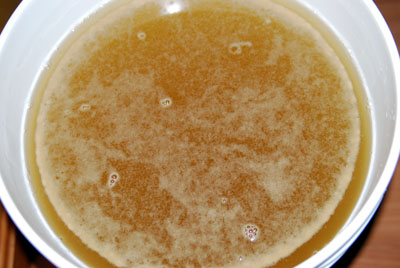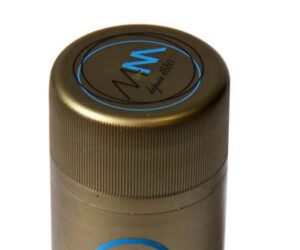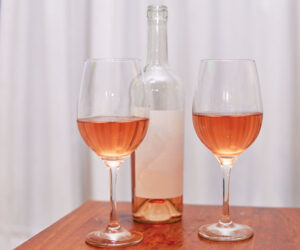Q
I came across your site while searching for answers about soapy taste in white wine. I have been making white and red wines for a while and I never had this issue. When I went to rack the white wine for the first time I noticed that it still had sugar residue, so I added yeast nutrients, which got the wine going again. Now when I taste the wine a few weeks later I’m getting the soapy taste. The pH is 3.76.
Carlos Cardoso
Via email
A
Though tough to define as it can smell different to everyone, there is unfortunately no wine lab analysis panel you can run that says, “Yessir, you’ve got an over-abundance of Ivory Soap Flakes on your hands.” However, if you don’t like it in your wine, it’s a problem. Delving into the wine chemistry literature of my UC-Davis days and through more current articles, what I was able to coax out of the woodwork is a group of culprits: fatty acids.
I will spare you all the “acetyl-coA anabolism of cytosol etc.” details, but in general know that fatty acids are a product of fermentation, both of Saccharomyces cerevisiae (the “good guys”) as well as other spoilage yeast like Brettanomyces (definitely the bad guys). Under normal, healthy fermentative conditions, S. cerevisiae can produce various fatty acids like butyric acid, propionic acid, and decanoic acid, which have aromatic descriptors like fatty, rancid butter or “soapy”. When fermentation conditions are healthy (more on that later), small amounts of these fatty acids can do good things for the wine, like combine with alcohol and to form aromatic esters, which add nicely to the fermentation “bouquet” of a wine. Fatty acid ethyl esters, like ethyl hexanoate and ethyl octanoate, reportedly smell like wax and honey, which can be a positive. Fatty acids may also be produced in small enough amounts that they just contribute to complexity of a wine without becoming overwhelming.
Which brings us to “overwhelming.” I suspect you’ve got a fatty acid issue caused by your stuck/sluggish fermentation. S. cerevisiae can emit fatty acids when under fermentative stress, and stuck/sluggish fermentations can also provide a rich environment for inoculation by other yeast species, who, as your “good guy” yeast struggle, can take over or at least gain a foothold where you may not want them. Ambient yeast like Kloeckera and Candida genera as well as notorious spoilage yeast like Brettanomyces can all produce fatty acids as well; Brettanomyces is famous for pumping out offensive amounts of decanoic (also called capric) acid CH3(CH2)8COOH, which, in addition to smelling soapy or fatty can inhibit S. cerevisiae and can be a causative or contributing factor to a stuck fermentation.
Decanoic acid, a 10-carbon medium-chain fatty acid, is naturally found not just in wine but also in plant oils, milk and animal fats. It often has an unpleasant odor that is described as waxy, soapy or even “goaty” (hence the capric part of the name) and is used in soap, pharmaceutical and plastics production. It and its medium-chain fatty acid brethren aren’t like something you want in high concentration in your wine. Decanoic acid occurs naturally in wine fermentation, however spoilage bacteria like Brettanomyces can produce excessive amounts. Whichever fatty acid is your main culprit, it’s clear that you should do your best to prevent stuck fermentations in your wines.
Causes of a stuck/sluggish fermentation can include, but aren’t limited to:
• High or low fermentation temperature
• Very high must or juice sugar concentration
• Low inoculation level of yeast
• Poor-vigor yeast starter culture and insufficient hydration/build up before pitching
• Pesticide residue on grapes
• Nutrient deficiency in must or juice
• Juice that is too clear (<1% solids)
• Presence of yeast inhibitors (like excessive decanoic acid) from spoilage organisms
Methods to prevent high fatty acid production:
• Inoculate with known S. cerevisiae species
• Keep pH’s reasonable — under 3.80 for all wines.
• Add SO2 at crushing/initial pressing (for whites) of grapes to help knock down wild yeast populations.
• Ensure timely, complete primary fermentation.
• Do not underfeed. Use a complex yeast nutrient so you have a healthy, complete fermentation.
• Do not overfeed. Residual nutrients can feed the bad guys.
• Do not ferment too cold.
• Add a little air during fermentation (but protect the wine once fermented).
To rule out Brettanomyces (especially if you smell aromas like cardboard, mouse cage, sweaty leather or Band-Aid), which can quickly infect your whole cellar if you do not keep the wine isolated, send a sample out to a wine lab for a 4-ethyl phenol/4-ethyl guaiacol analyses.
But what can you do about the soapy taste in your wine right now? Try adding yeast hulls, AKA yeast ghosts, or freeze-dried dead yeast cells. They are inexpensive, easy to find at most winemaking suppliers, store almost indefinitely and are a great tool to have in your cellar. They can be used as a source of micronutrients for fermentation, can actually absorb toxins produced by yeast if you have a stuck fermentation happening, and can absorb fatty acids in wine. According to one study, just by adding 1 g/L yeast hulls to a fermentation or wine you can soak up about 50% of the decanoic acid in your wine. Yeast hulls also add micronutrients and survival factors to a fermentation. I add them at around 1–2 g/L at the first sign of a sluggish fermentation.
You can also experiment with adding some acid to your wine. A reading of 3.76 is a bit high for my tastes for a white, and you might find the high-pH “slippery” feeling you might experience in the mouthfeel to be lessened once you add a little tartaric acid. Do bench trials so you’re only adding what you want to bring the mouthfeel and taste into balance.
Q
My strawberry wine is clear after about four months in the secondary and the specific gravity (S.G.) tells me it is ready to bottle. The fruit I used was purchased in a grocery store — strawberries, canned pears and canned peaches. I also used grape concentrates. What do I list on the label as to the vintage? Date starting the wine? Or date after complete fermentation? Or bottling date?
Thomas Jones
Pickering, Ohio
A
Well well, what do you know? That’s a question I’ve never been asked before in all my years of writing this column!
The spirit of the vintage laws for commercial wine is that the year on the label, if one is listed, reflect the year that the fresh fruit was grown. This is so consumers can, presumably, tell if it was a good year, or can help keep track of it in their cellar for aging. For blended wines like Port, some sparkling wines, and others, where a consistent house style is more important than the exact vintage date, the year is frequently not listed and is not seen as needed as a quality indicator. However, it is possible to see a “vintage” Port or Champagne where the producer thinks that the single vintage was so good as to make a special bottling from that year alone.
In your case, since it’s hard to tell the year of canned fruit, frozen fruit or concentrate, it’s impossible to give you a recommendation on vintage. Next time you use shelf-stable products for fermentation, check out the expiration date. I would hazard a guess that most frozen fruit had been picked the ripening season closest to your purchase date. Be sure to check the hemisphere of origin, however — the fresh fruit harvest in Chile, for example, is during our Northern Hemisphere winter. Grape concentrate should be pretty easy to source; because the question often comes up in winemaking many suppliers list the vintage year on the container. Canned fruit is a different matter as these items can last years on the shelf and your average pear canner in the US probably isn’t worrying about persnickety winemakers . . . they’re just concerned with the expiration date. In your case, I would think that you could just take your best guess on a date and no one but you will be the wiser, or you could go with the month or year when you started your fermentation, which is sort of like adding disgorgement dates on sparkling wine labels.
Q
I was wondering what I could use that is not very expensive to pump and transfer that won’t leave a plastic taste when I rack my wine from a 70-gallon (265-L) tank? I am living in the Philippines, and equipment is limited here! They have Italian water pumps here for bottled water business and fish and pond pumps as well. Any suggestions?
Rob
The Philippines
A
Wow, can I fly to the Philippines for a little research and equipment-scouting trip? We can sample some of your wine, do a little research into tropical fruit winemaking, go see what kind of Italian water pumps you may have in local stores . . . hmmm. Somehow I don’t think that idea would fly with the editors of WineMaker magazine.
I would stay away from using fish and pond pump systems for wine. First of all, there is no guarantee the parts will be food grade, and secondly they are built to handle water, which has a much higher pH (around 7.0) than wine (around 3.50). Thirdly, water pumps are not built to handle anything with alcohol in it, and alcohol is an even better solvent than water is. Parts (metal or plastic) in fish and pond pumps could therefore degrade and corrode in the more acidic and alcoholic environment of your wine, leaching potentially toxic compounds into your beverages.
Unfortunately the Italian water pump system faces this latter challenge too. Though presumably a food-grade system, it’s a system designed for water and not for wine. Unless you could get a copy of the manufacturer’s material specifications to find out what the water pump is made of or from, and then do a little research to see if that material will hold up to wine use. If its components are stainless steel, polyethylene or polypropylene or food-grade vinyl you are probably good to go.
There’s no doubt that international shipping costs can really add up. To that end, have you completely explored what might already be available in the Philippines? Googling around, I found some interesting references to winemaking in your country of residence. There seems to be an active fruit winemaking industry in the Philippines and a native tradition that is receiving some bolstering from the local universities and trade schools in order to further develop the industry. You might want to seek out some of your local wineries and ask them where they get their stuff, or make inquiries into the food processing, food science or agricultural technology departments of colleges in larger cities.
If all else fails, have friends bring you equipment in their suitcases when they come visit, or be prepared to pay overseas shipping costs. I made some inquiries into some of the larger winemaking supply houses and most will ship overseas wherever FedEx delivers. All you have to do is ask . . . and see how much it costs. I wish you all the best of luck!
Q
When measuring SO2 using the Ripper method for red wine, if you dilute the wine with distilled water to more easily detect the color change, will the reading be correct as read, or is it necessary to multiply the reading by the dilution factor? Since the reading is in parts per million (ppm) SO2, it would seem that the reading would reflect ppm SO2 of the total volume of solution. Even though the amount of SO2 is unchanged, the concentration is now less.
G. Wayne Baggett
Friendswood, Texas
A
The short answer to your question: yes, if you dilute your wine sample before running a Ripper analysis for SO2, you then need to multiply your result by the dilution factor you used in order to get a correct result for the true batch of wine. It’s indeed common for winemakers to dilute red wine by half or even two thirds in order to be able to better see the titration endpoint color change. It’s tough to see the color when you are testing really dark red wine. So, for example, if you dilute your red wine by half and get a result of 10 ppm SO2, your real result for your real batch of wine is 20 ppm SO2. My preferred method of SO2 analysis is the aeration/oxidation method. I find it easier to do and more accurate than the Ripper method. Though the equipment looks a little fiddly and can be expensive, I find it’s worth it because we run so many SO2 tests. Slightly cheaper, smaller versions of the equipment that many winery labs have are available from some of the larger winemaking supply companies for around $100







